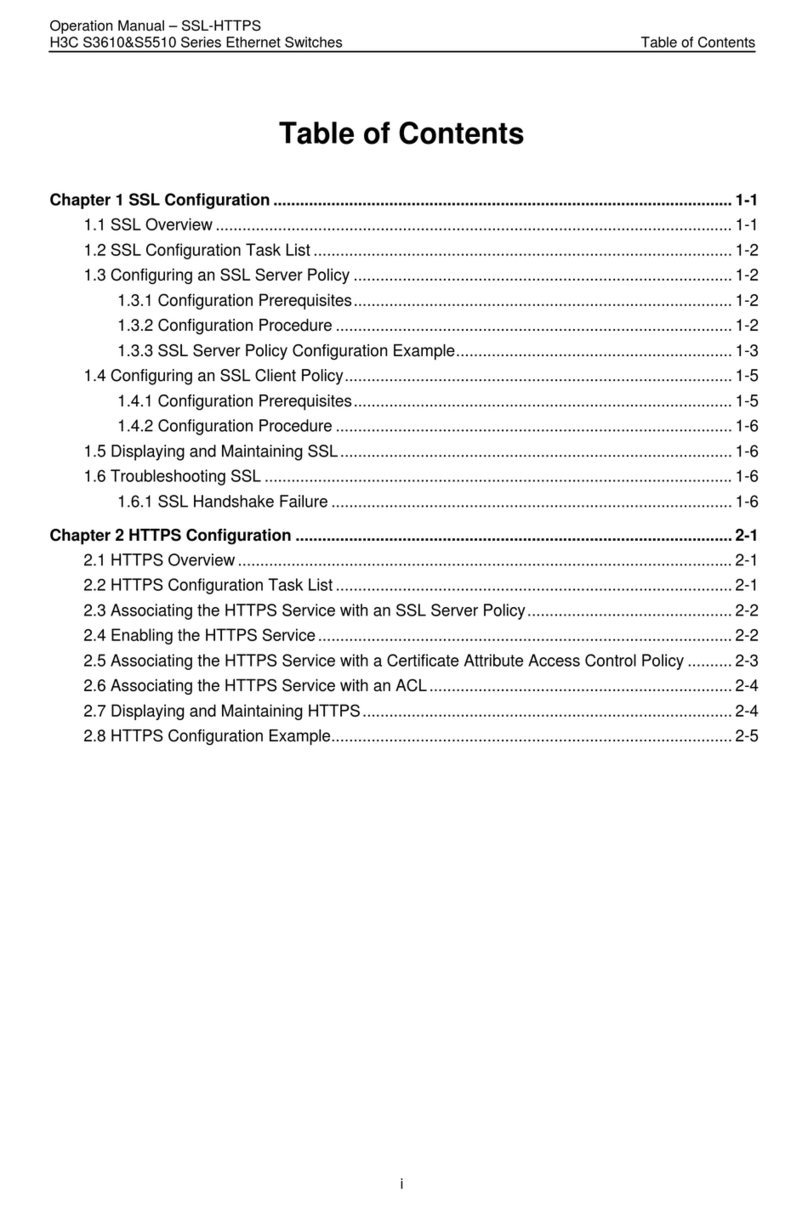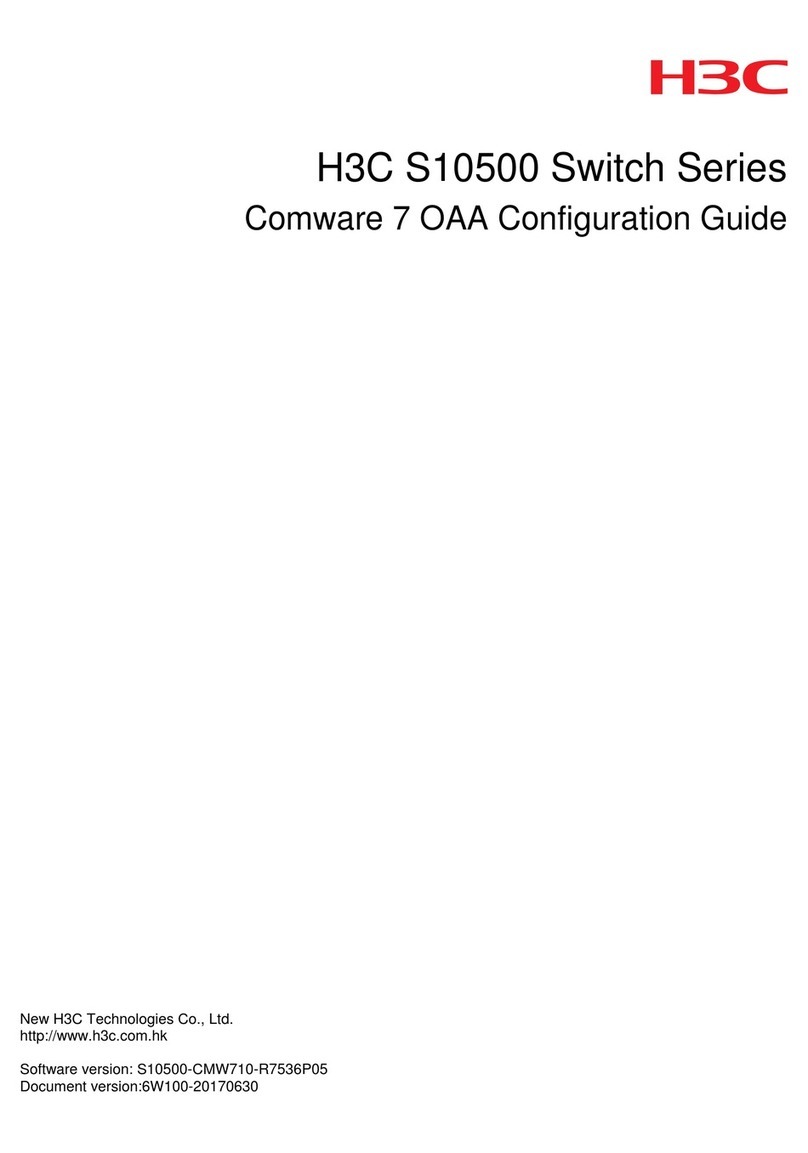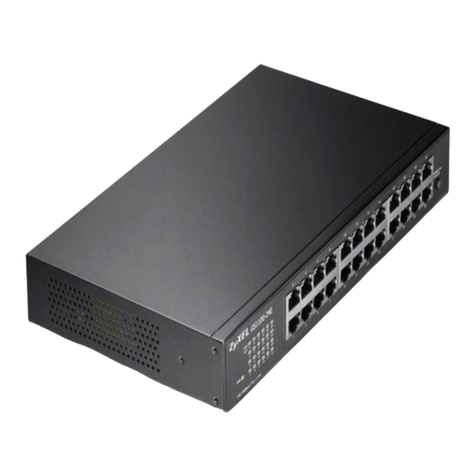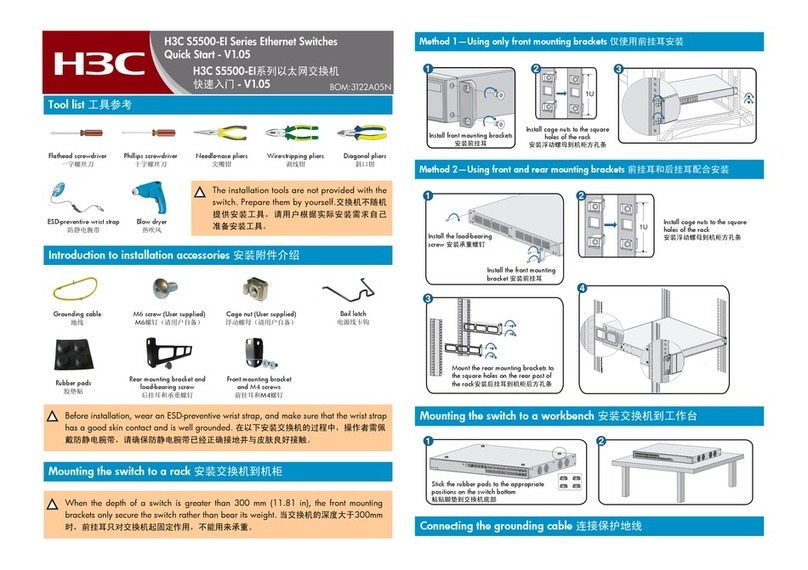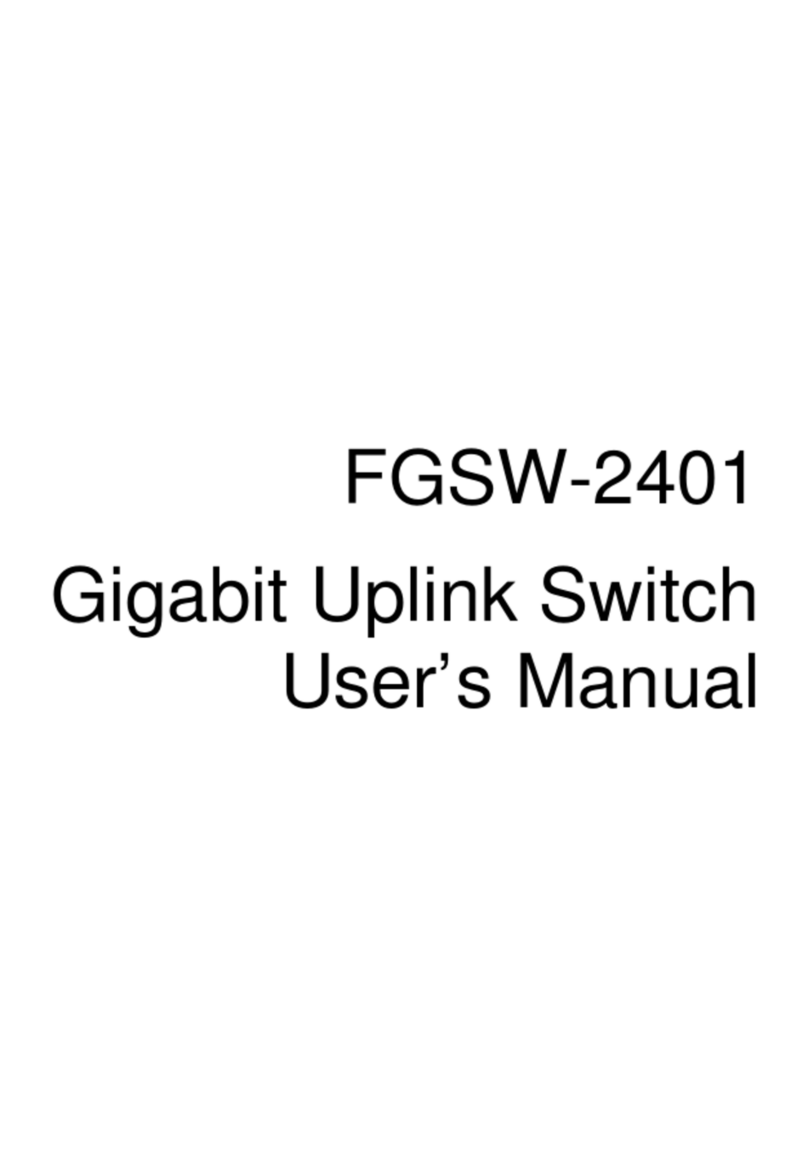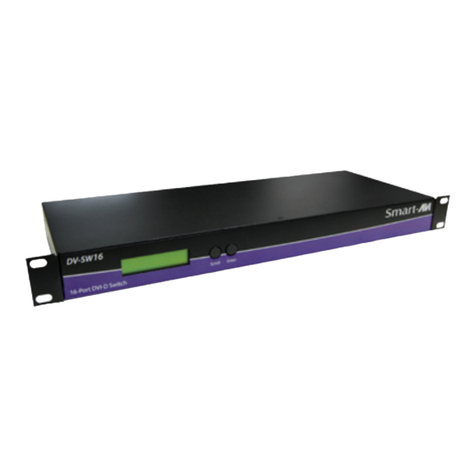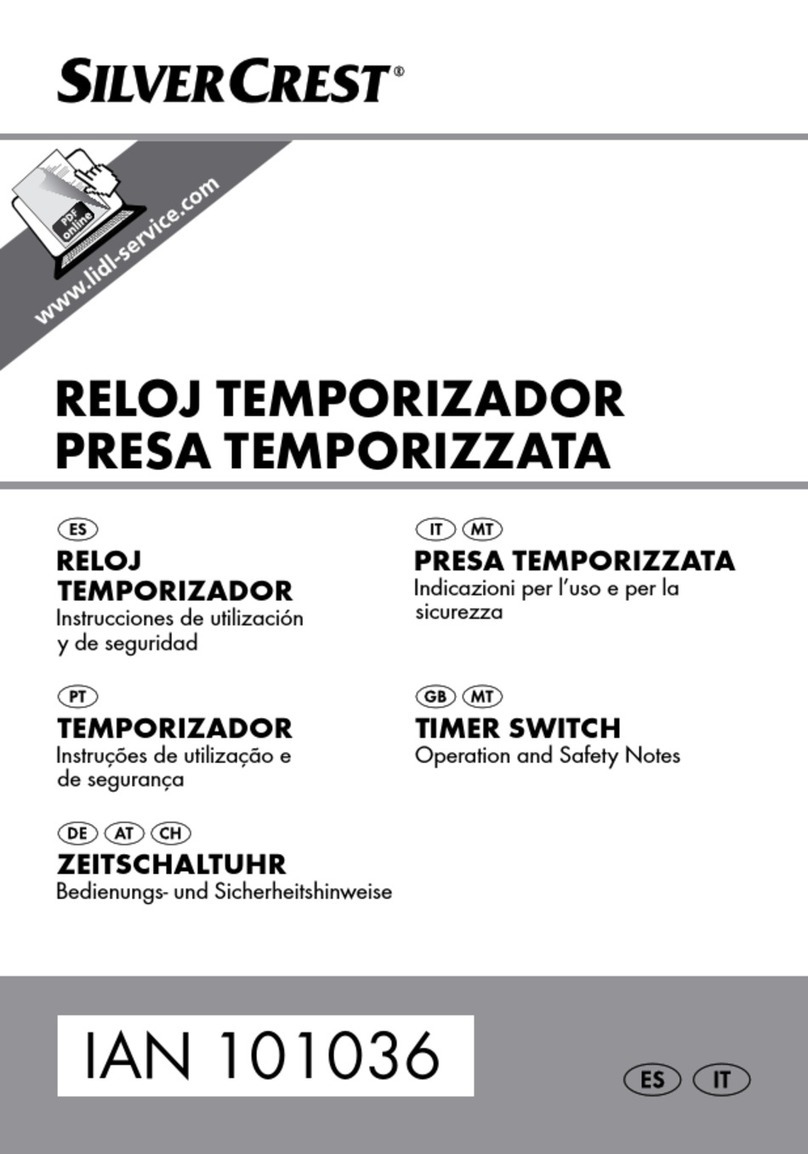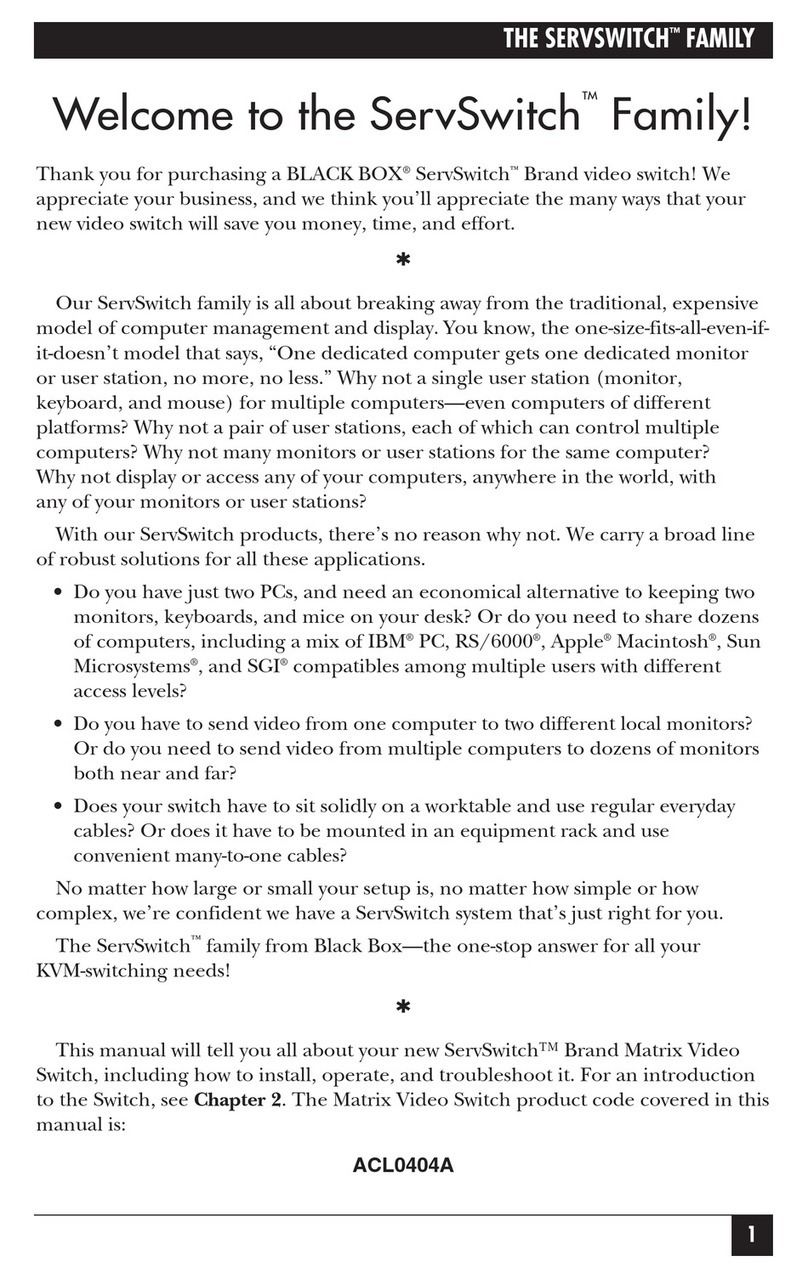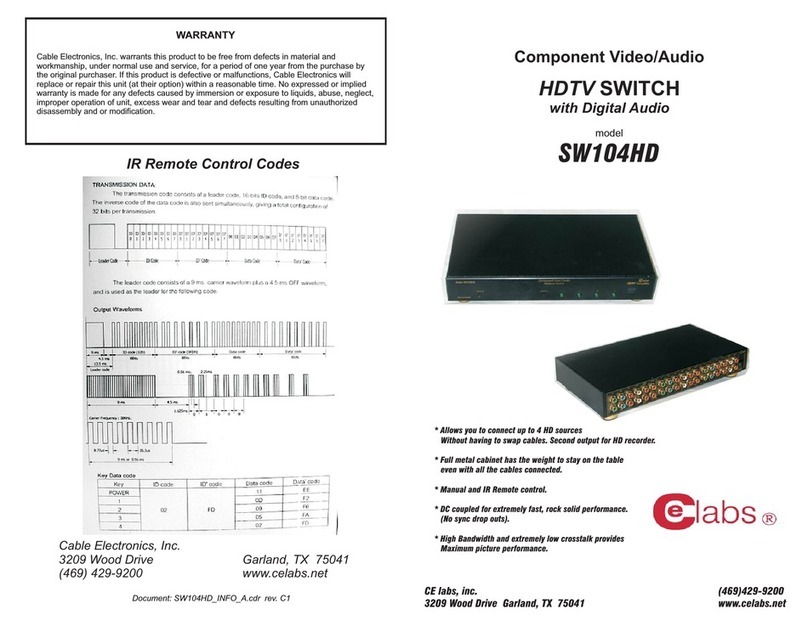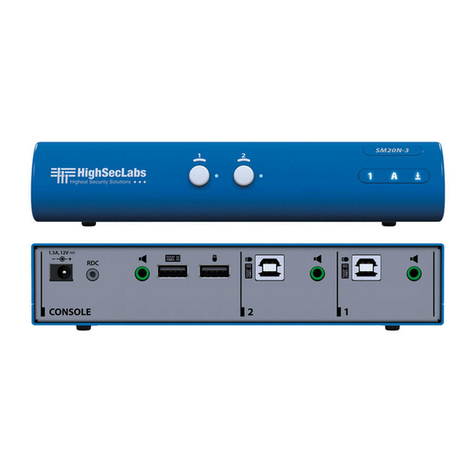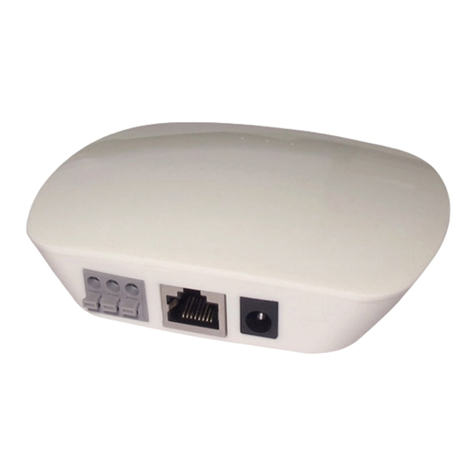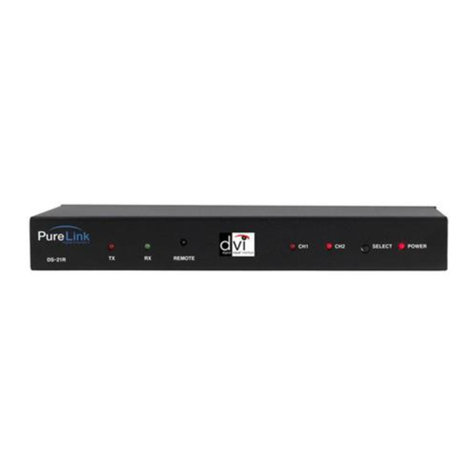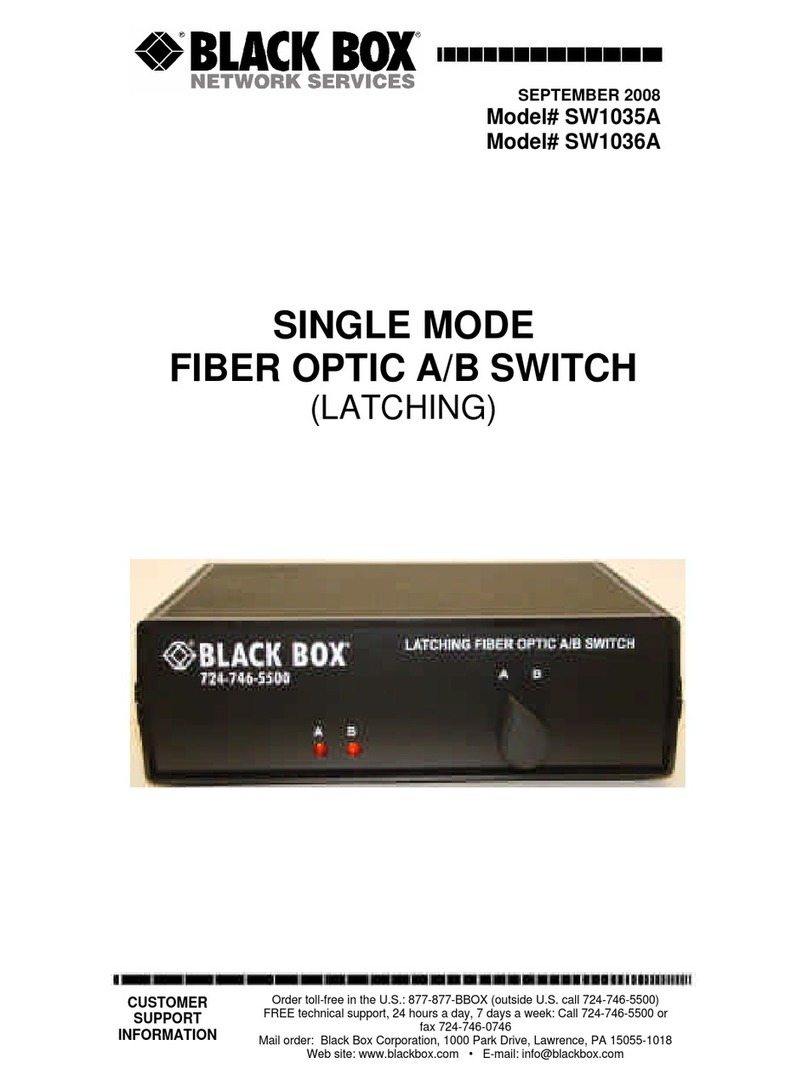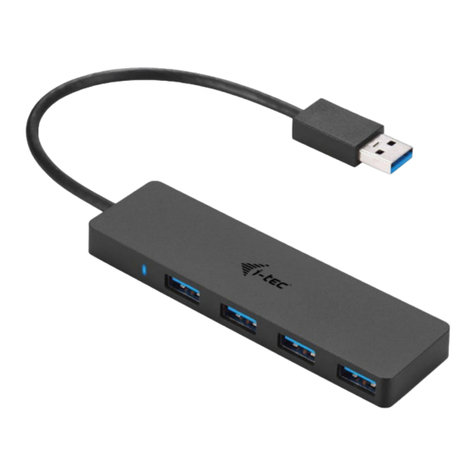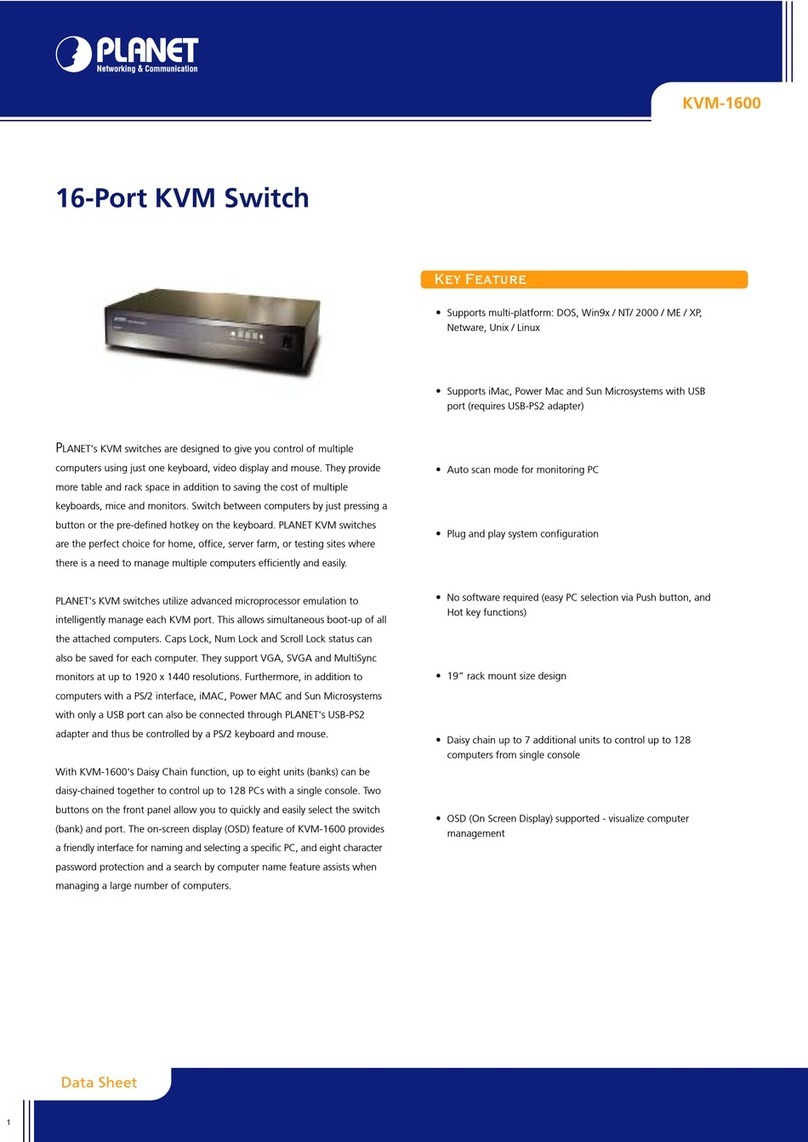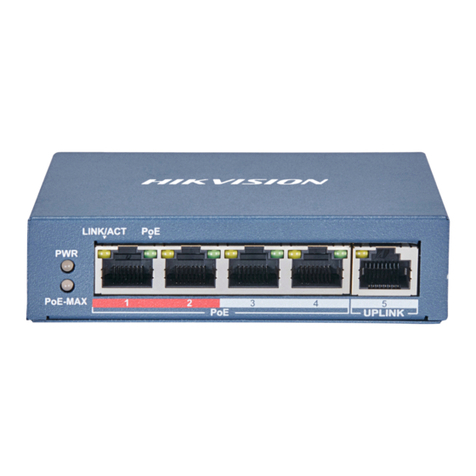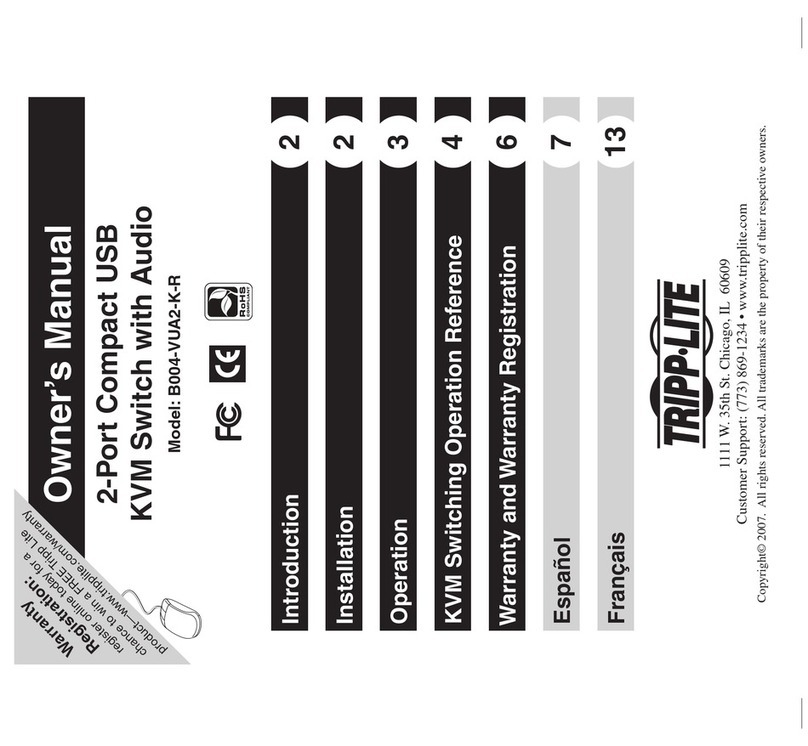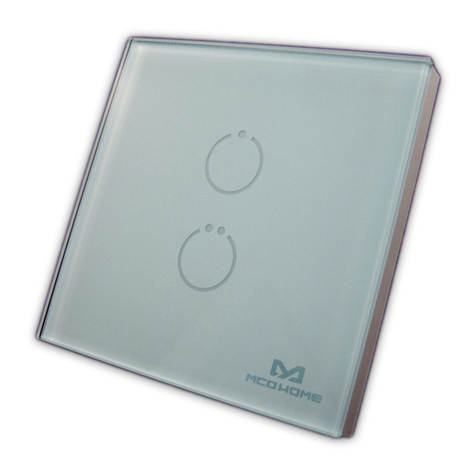H3C H3C S5100-SI User manual

H3C S5100-SI/EI Series Ethernet Switches
Operation Manual
Hangzhou H3C Technologies Co., Ltd.
http://www.h3c.com
Manual Version: 20081128-C-1.04
Product Version: Release 2201

Copyright © 2007-2008, Hangzhou H3C Technologies Co., Ltd. and its licensors
All Rights Reserved
No part of this manual may be reproduced or transmitted in any form or by any means
without prior written consent of Hangzhou H3C Technologies Co., Ltd.
Trademarks
H3C, , Aolynk, , H3Care,
, TOP G, , IRF, NetPilot,
Neocean, NeoVTL, SecPro, SecPoint, SecEngine, SecPath, Comware, Secware,
Storware, NQA, VVG, V2G, VnG, PSPT, XGbus, N-Bus, TiGem, InnoVision and
HUASAN are trademarks of Hangzhou H3C Technologies Co., Ltd.
All other trademarks that may be mentioned in this manual are the property of their
respective owners.
Notice
The information in this document is subject to change without notice. Every effort has
been made in the preparation of this document to ensure accuracy of the contents, but
all statements, information, and recommendations in this document do not constitute
the warranty of any kind, express or implied.
Technical Support
customer_service@h3c.com
http://www.h3c.com

About This Manual
Organization
H3C S5100-SI/EI Series Ethernet Switches Operation Manual is organized as follows:
Part Contents
0 Product Overview Introduces the characteristics and
implementations of the Ethernet switch.
1 Login Introduces the ways to log into an Ethernet switch
and CLI related configuration.
2 Configuration File
Management Introduces configuration file and the related
configuration.
3 VLAN Introduces VLAN-/Voice VLAN-related
configuration.
4 Management VLAN Introduces the management VLAN configuration
and DHCP/BOOTP client configuration.
5 Voice VLAN Introduces voice VLAN and the related
configuration.
6 GVRP Introduces GVRP and the related configuration.
7 Port Basic Configuration Introduces basic port configuration.
8 Link Aggregation Introduces link aggregation and the related
configuration.
09 Port Isolation Introduces port isolation and the related
configuration.
10 Port Security-Port Binding Introduces port security, port binding, and the
related configuration.
11 DLDP Introduces DLDP and the related configuration.
12 MAC Address Table
Management Introduces MAC address forwarding table
management.
13 MSTP Introduces STP and the related configuration.
14 802.1x and System Guard Introduces 802.1x and the related configuration.
15 AAA Introduces AAA, RADIUS, HWTACACS, EAD, and
the related configurations.
16 MAC Address
Authentication Introduces centralized MAC address
authentication and the related configuration.
17 IP Address and
Performance Introduces IP address and IP performance related
configuration

Part Contents
18 DHCP Introduces DHCP-Snooping, DHCP Client and the
related configuration.
19 ACL Introduces ACL and the related configuration.
20 QoS-QoS Profile Introduces QoS and the related configuration.
21 Mirroring Introduces mirroring and the related configuration.
22 ARP Introduces ARP and the related configuration.
23 Stack-Cluster Introduces the related configuration for cluster
management by using HGMP V2.
24 SNMP-RMON Introduces the configuration for network
management through SNMP and RMON
25 Multicast Introduces IGMP snooping and the related
configuration.
26 NTP Introduces NTP and the related configuration.
27 SSH Introduces SSH2.0 and the related configuration.
28 File System Management Introduces basic configuration for file system
management.
29 FTP-SFTP-TFTP Introduces basic configuration for FTP, SFTP and
TFTP, and the applications.
30 Information Center Introduces information center configuration.
31 System Maintenance and
Debugging Introduces daily system maintenance and
debugging.
32 VLAN-VPN Introduces VLAN VPN and the related
configuration.
33 HWPing Introduces HWPing and the related configuration.
34 DNS Introduces DNS and the related configuration.
35 Smart Link-Monitor Link Introduces Smart Link, Monitor Link and the
related configuration.
36 IPv6 Management Introduces IPv6 and the related configuration.
37 PoE-PoE Profile Introduces PoE, PoE profile and the related
configuration.
38 Appendix Lists the acronyms used in this manual

Conventions
The manual uses the following conventions:
I. Command conventions
Convention Description
Boldface The keywords of a command line are in Boldface.
italic Command arguments are in italic.
[ ] Items (keywords or arguments) in square brackets [ ] are
optional.
{ x | y | ... }
Alternative items are grouped in braces and separated by
vertical bars. One is selected.
[ x | y | ... ]
Optional alternative items are grouped in square brackets
and separated by vertical bars. One or none is selected.
{ x | y | ... } *
Alternative items are grouped in braces and separated by
vertical bars. A minimum of one or a maximum of all can be
selected.
[ x | y | ... ] *
Optional alternative items are grouped in square brackets
and separated by vertical bars. Many or none can be
selected.
&<1-n> The argument(s) before the ampersand (&) sign can be
entered 1 to n times.
# A line starting with the # sign is comments.
II. GUI conventions
Convention Description
< > Button names are inside angle brackets. For example, click
<OK>.
[ ] Window names, menu items, data table and field names
are inside square brackets. For example, pop up the [New
User] window.
/ Multi-level menus are separated by forward slashes. For
example, [File/Create/Folder].

III. Symbols
Convention Description
Warning Means reader be extremely careful. Improper operation
may cause bodily injury.
Caution Means reader be careful. Improper operation may cause
data loss or damage to equipment.
Note Means a complementary description.
Related Documentation
In addition to this manual, each H3C S5100-SI/EI Series Ethernet Switches
documentation set includes the following:
Manual Description
H3C S5100-SI/EI Series Ethernet
Switches Installation Manual It provides information for the system
installation.
H3C S5100-SI/EI Series Ethernet
Switches Command Manual It is used for assisting the users in using
various commands.
Obtaining Documentation
You can access the most up-to-date H3C product documentation on the World Wide
Web at this URL: http://www.h3c.com.
The following are the columns from which you can obtain different categories of product
documentation:
[Products & Solutions]: Provides information about products and technologies.
[Technical Support & Document > Technical Documents]: Provides several categories
of product documentation, such as installation, configuration, command, and
maintenance.
[Technical Support & Document > Product Support > Software]: Provides the
documentation released with the software version.
Documentation Feedback
We appreciate your comments.

Operation Manual – Product Overview
H3C S5100-SI/EI Series Ethernet Switches Table of Contents
i
Table of Contents
Chapter 1 Obtaining the Documentation ....................................................................................1-1
1.1 CD-ROM............................................................................................................................1-1
1.2 H3C Website......................................................................................................................1-1
1.3 Software Release Notes....................................................................................................1-2
Chapter 2 Correspondence Between Documentation and Software .......................................2-1
2.1 Software Version................................................................................................................2-1
2.2 Manual List.........................................................................................................................2-1
Chapter 3 Product Overview ........................................................................................................3-1
3.1 Preface...............................................................................................................................3-1
3.2 System Features of the S5100 Series...............................................................................3-3
3.2.1 System Features of the S5100-SI Series................................................................3-3
3.2.2 System Features of the S5100-EI Series................................................................3-4
Chapter 4 Networking Applications............................................................................................. 4-1
4.1 Convergence Layer Devices..............................................................................................4-1
4.2 Access Layer Devices .......................................................................................................4-2
4.3 Data Center Access...........................................................................................................4-2

Operation Manual – Product Overview
H3C S5100-SI/EI Series Ethernet Switches Chapter 1 Obtaining the Documentation
1-1
Chapter 1 Obtaining the Documentation
H3C Technologies Co., Ltd. provides various ways for you to obtain documentation,
through which you can obtain the product documentations and those concerning newly
added new features. The documentations are available in one of the following ways:
zCD-ROMs shipped with the devices
zH3C website
zSoftware release notes
1.1 CD-ROM
H3C delivers a CD-ROM together with each device. The CD-ROM contains a complete
product document set, including the operation manual, command manual. After
installing the reader program provided by the CD-ROM, you can search for the desired
contents in a convenient way through the reader interface.
The contents in the manual are subject to update on an irregular basis due to product
version upgrade or some other reasons. Therefore, the contents in the CD-ROM may
not be the latest version. This manual serves the purpose of user guide only. Unless
otherwise noted, all the information in the document set does not claim or imply any
warranty. For the latest software documentation, go to the H3C website.
1.2 H3C Website
Perform the following steps to query and download the product documentation from the
H3C website.
Table 1-1 Acquire product documentation from the H3C website
How to apply for an account
Access the homepage of H3C at http://
www.h3c.com and click on Registration at the top
right. In the displayed page, provide yourinformation
and click on Submit to register.
How to get documentation
Approach 1:
In the homepage of H3C at http:// www.h3c.com,
select Technical Support & Document > Technical
Documents from the navigation menu at the top.
Then select a product for its documents.
Approach 2:
In the homepage of H3C at http:// www.h3c.com,
select Support > Technical Documents. Then select
a product for its documents.

Operation Manual – Product Overview
H3C S5100-SI/EI Series Ethernet Switches Chapter 1 Obtaining the Documentation
1-2
1.3 Software Release Notes
With software upgrade, new software features may be added. You can acquire the
information about the newly added software features through software release notes.

Operation Manual – Product Overview
H3C S5100-SI/EI Series Ethernet Switches Chapter 2 Correspondence Between
Documentation and Software
2-1
Chapter 2 Correspondence Between
Documentation and Software
2.1 Software Version
H3C S5100-SI/EI Series Ethernet Switches Operation Manual-Release 2201 and H3C
S5100-SI/EI Series Ethernet Switches Command Manual-Release 2201 are for the
software version of Release2201 of the S5100-SI/EI series products.
Compared with Release 2200, a new feature is added in Release 2201. For details,
refer to Table 2-1.
Table 2-1 Added features in Release 2201
Added feature in Release 2201 Manual
Identifying and Diagnosing Pluggable Transceivers 32-System Maintenance and
Debugging
2.2 Manual List
Manual name Version
H3C S5100-SI/EI Series Ethernet Switches Installation
Manual (V1.05)
H3C S5100-SI/EI Series Ethernet Switches Operation
Manual-Release 2201 (V1.04)
H3C S5100-SI/EI Series Ethernet Switches Command
Manual-Release 2201 (V1.04)

Operation Manual – Product Overview
H3C S5100-SI/EI Series Ethernet Switches Chapter 3 Product Overview
3-1
Chapter 3 Product Overview
Note:
For the convenience of users, units of Mega bps/1000 Mega bps in the following
chapters are simplified as M/G.
3.1 Preface
H3C S5100-SI/EI Series Ethernet Switches (hereinafter referred to as S5100-SI/EI
series) are Gigabit Ethernet switching products developed by H3C Technologies Co.,
Ltd. H3C S5100-SI/EI series provide a variety of service features and powerful QACL
functions. S5100-SI/EI series are designed as convergence and access devices for
intranets and metropolitan area networks (MANs), and can also be used for connecting
data center server clusters.
The H3C S5100 series come in two series: S5100-SI and S5100-EI, which are
available in the following models:

Operation Manual – Product Overview
H3C S5100-SI/EI Series Ethernet Switches Chapter 3 Product Overview
3-2
Table 3-1 H3C S5100-SI/EI series
Series Model 10/100/1000Base-T
autosensing
Ethernet port
1000Base-
X SFP port Console
port
S5100-8P-SI 8 2
S5100-16P-SI 16
S5100-24P-SI 24
S5100-SI
S5100-48P-SI 48
4
S5100-8P-EI 8 2
S5100-16P-EI 16
S5100-24P-EI 24
S5100-48P-EI 48
S5100-26C-EI 24
S5100-50C-EI 48
4
S5100-8P-PWR-EI 8 2
S5100-16P-PWR-EI 16
S5100-26C-PWR-EI 24
S5100-EI
S5100-50C-PWR-EI 48
4
1
An SFP port and its corresponding 10/100/1000Base-T autosensing Ethernet port form
a Combo port. That is, only one of the two ports forming the Combo port can be used at
a time. Table 3-2 shows the mapping relations between the ports forming the Combo
port.
Table 3-2 Mapping relations between the ports forming the Combo port
Model 1000Base-X SFP port 10/100/1000Base-T
autosensing Ethernet port
17 14
18 16
19 13
S5100-16P-SI
S5100-16P-EI
S5100-16P-PWR-EI 20 15
25 22
26 24
27 21
S5100-24P-SI
S5100-24P-EI
S5100-26C-EI
S5100-26C-PWR-EI 28 23

Operation Manual – Product Overview
H3C S5100-SI/EI Series Ethernet Switches Chapter 3 Product Overview
3-3
Model 1000Base-X SFP port 10/100/1000Base-T
autosensing Ethernet port
49 46
50 48
51 45
S5100-48P-SI
S5100-48P-EI
S5100-50C-EI
S5100-50C-PWR-EI 52 47
3.2 System Features of the S5100 Series
3.2.1 System Features of the S5100-SI Series
Table 3-3 System features of the S5100-SI series
Item S5100-8P-SI S5100-16P-SI S5100-24P-SI S5100-48P-SI
Dimensions
(H × W × D)
43.6 × 230 ×
200 mm (1.7 ×
9.1 × 7.9 in.)
43.6 × 300 ×
220 mm (1.7 ×
11.8 × 8.7 in.)
43.6 × 440 × 260 mm (1.7 ×
17.3 × 10.2 in.)
Weight < 1.6 kg (< 3.5
lb.) < 2.3 kg (< 5.1
lb.) < 4 kg (< 8.8
lb.) 4 kg (8.8 lb.)
Service ports
8 ×
10/100/1000Ba
se-T
autosensing
Ethernet ports
2 ×
1000Base-X
SFP ports
16 ×
10/100/1000B
ase-T
autosensing
Ethernet ports
4 Gigabit SFP
Combo ports
24 ×
10/100/1000
Base-T
autosensing
Ethernet ports
4 Gigabit SFP
Combo ports
48 ×
10/100/1000
Base-T
autosensing
Ethernet ports
4 Gigabit SFP
Combo ports
Management
port One console port
Power
supply
system
The S5100-SI series support AC power input.
Rated voltage range: 100 VAC to 240 VAC, 50 Hz or 60Hz
Max voltage range: 90 VAC to 264 VAC, 47 Hz to 63 Hz
Max power
consumption 16 W 25 W 39 W 78 W
Fan 1 1 1 2
Operating
temperature 0°C to 45°C (32°F to 113°F)
Relative
humidity
(noncondens
ing)
10% to 90%

Operation Manual – Product Overview
H3C S5100-SI/EI Series Ethernet Switches Chapter 3 Product Overview
3-4
3.2.2 System Features of the S5100-EI Series
Table 3-4 System features of the S5100-EI series (1)
Item S5100-8P-EI S5100-16P-EI S5100-24P-EI S5100-48P-EI
Dimensions
(H × W × D)
43.6 × 230 ×
200 mm (1.7 ×
9.1 × 7.9 in.)
43.6 × 300 ×
220 mm (1.7 ×
11.8 × 8.7 in.)
43.6 × 440 × 260 mm (1.7 × 17.3
× 10.2 in.)
Weight < 1.6 kg (< 3.5
lb.) < 2.3 kg (< 5.1
lb.) < 4 kg (< 8.8
lb.) 4 kg (8.8 lb.)
Service ports
8 ×
10/100/1000B
ase-T
autosensing
Ethernet ports
2 ×
1000Base-X
SFP ports
16 ×
10/100/1000Ba
se-T
autosensing
Ethernet ports
4 Gigabit SFP
Combo ports
24 ×
10/100/1000B
ase-T
autosensing
Ethernet ports
4 Gigabit SFP
Combo ports
48 ×
10/100/1000B
ase-T
autosensing
Ethernet ports
4 Gigabit SFP
Combo ports
Management
port One console port
Power
supply
system
The S5100-EI series support AC input and DC input.
AC input:
Rated voltage range: 100 VAC to 240 VAC, 50 Hz or 60Hz
Max voltage range: 90 VAC to 264 VAC, 47 Hz to 63 Hz
DC input (for the S5100-24P-EI and S5100-48P-EI):
Rated voltage range: -48 VDC to -60 VDC
Max voltage range:-36 VDC to -72 VDC
Max power
consumption 18 W 26 W 46 W 97 W
Fan 1 1 1 2
Operating
temperature 0°C to 45°C (32°F to 113°F)
Relative
humidity
(noncondens
ing)
10% to 90%
Table 3-5 System features of the S5100-EI series (2)
Item S5100-26C-EI S5100-50C-EI
Dimensions
(H × W × D) 43.6 × 440 × 300 mm (1.7 × 17.3 × 11.8 in.)
Weight 4 kg (8.8 lb.) < 5 kg (< 11 lb.)

Operation Manual – Product Overview
H3C S5100-SI/EI Series Ethernet Switches Chapter 3 Product Overview
3-5
Item S5100-26C-EI S5100-50C-EI
Service ports 24 × 10/100/1000MBase-T
autosensing Ethernet ports
4 Gigabit SFP Combo ports
48 × 10/100/1000MBase-T
autosensing Ethernet ports
4 Gigabit SFP Combo ports
Extension
slots Two 10 G slots Two 10 G slots
Management
port One console port
Power supply
system
The S5100-EI series support AC input and DC input.
AC input:
Rated voltage range: 100 VAC to 240 VAC, 50 Hz or 60Hz
Max voltage range: 90 VAC to 264 VAC, 47 Hz to 63 Hz
DC input:
Rated voltage range: -48 VDC to -60 VDC
Max voltage range: -36 VDC to -72 VDC
Max power
consumption 68 W 116 W
Fan 2 3
Operating
temperature 0°C to 45°C (32°F to 113°F)
Relative
humidity
(noncondensi
ng)
10% to 90%
Table 3-6 System features of the S5100-EI series (3)
Item S5100-8P
-PWR-EI S5100-16P
-PWR-EI S5100-26C-PW
R-EI S5100-50C-PWR
-EI
Dimensions
(H × W × D)
43.6 ×
300 × 220
mm (1.7 ×
11.8 × 8.7
in.)
43.6 × 300
× 260 mm
(1.7 × 11.8
× 10.2 in.)
43.6 × 440 × 420 mm (1.7 × 17.3 ×
16.5 in.)
Weight 2.5 kg (5.5
lb.) < 3.1 kg (<
6.8 lb.) < 6.9 kg (15.2
lb.) < 7.4 kg (16.3 lb.)
Management
port One console port

Operation Manual – Product Overview
H3C S5100-SI/EI Series Ethernet Switches Chapter 3 Product Overview
3-6
Item S5100-8P
-PWR-EI S5100-16P
-PWR-EI S5100-26C-PW
R-EI S5100-50C-PWR
-EI
Service ports
8 ×
10/100/10
00Base-T
autosensi
ng
Ethernet
ports
2 ×
1000Base
-X SFP
ports
16 ×
10/100/100
0 Base-T
autosensin
g Ethernet
ports
4 Gigabit
SFP
Combo
ports
24 ×
10/100/1000Ba
se-T
autosensing
Ethernet ports
4 Gigabit SFP
Combo ports
48 × 10/100/1000
Base-T
autosensing
Ethernet ports
4 Gigabit SFP
Combo ports
Extension slots — — Two 10 G slots Two 10 G slots
Input voltage
The S5100-EI series support AC input and DC input.
AC input:
Rated voltage range: 100 VAC to 240 VAC, 50 Hz or 60Hz
Max voltage range: 90 VAC to 264 VAC, 47 Hz to 63 Hz
DC input (for S5100-26C-PWR-EI and S5100-50C-PWR-EI):
Voltage range: -52 VDC to -55 VDC
Max
power
consum
ption
100 W 170 W AC input: 500 W
DC input:435 W AC input: 540 W
DC input: 840 W
When
all the
ports
provid
e PoE
extern
ally
Max
power
supplied
external
ly (PoE)
15.4 W ×
4 15.4 W × 8 15.4 W × 24
AC input: 15.4 W
× 24
DC input: 15.4 W
× 48
Fan 2 3
Two fans for
cooling the
whole device
Three fans for
cooling the
power supply
system
Three fans for
cooling the whole
device
Three fans for
cooling the power
supply system
Operating
temperature 0°C to 45°C (32°F to 113°F)
Relative humidity
(noncondensing) 10% to 90%

Operation Manual – Product Overview
H3C S5100-SI/EI Series Ethernet Switches Chapter 4 Networking Applications
4-1
Chapter 4 Networking Applications
S5100-SI/EI series Gigabit Ethernet switches are designed as convergence layer
switches or access layer switches for enterprise networks and metropolitan area
networks (MANs).
S5100-SI/EI series provide 24 or 48 autosensing Gigabit Ethernet ports for connecting
downstream devices. In addition, S5100-26C-EI and S5100-50C-EI also provide two
10GE extension slots to support flexible networking by means of optional XFPinterface
cards / XENPAK optical modules / dedicated stack cards for Gigabit Ethernet to the
desktop (GTTD) access of enterprise networks, user access and convergence of
carrier networks, and connection of data center server clusters.
Several typical networking applications are described as follows. (The following
applications are for S5100-EI series.)
4.1 Convergence Layer Devices
In medium- and small-sized enterprises or branches of large enterprises, S5100-EI
series Ethernet switches can serve as convergence layer switches that provide
high-performance and large-capacity switching service and support 10GE uplink ports,
which provide larger bandwidth for the devices. S5100-EI series also support abundant
QoS features to facilitate users to configure networks with a variety of features.
Figure 4-1 Application of S5100-EI series in the convergence layer of intranet/MAN

Operation Manual – Product Overview
H3C S5100-SI/EI Series Ethernet Switches Chapter 4 Networking Applications
4-2
4.2 Access Layer Devices
S5100-EI series Gigabit Ethernet switches can serve as access layer switches that
provide large access bandwidth and high port density. In addition, S5100-EI series also
provide powerful QACLfeatures to allow users to better design and plan their networks.
Figure 4-2 Application of S5100-EI series in the access layer
4.3 Data Center Access
In the networking of a data center, S5100-EI series are deployed on the core network to
provide 10GE/GE access core network functions. The server cluster can be connected
to the core network at the Gigabit Ethernet rate through S5100-EI series switches.
Figure 4-3 Application of S5100-EI series in data center networking

Operation Manual – Login
H3C S5100-SI/EI Series Ethernet Switches Table of Contents
i
Table of Contents
Chapter 1 Logging In to an Ethernet Switch ..............................................................................1-1
1.1 Logging In to an Ethernet Switch.......................................................................................1-1
1.2 Introduction to the User Interface ......................................................................................1-1
1.2.1 Supported User Interfaces......................................................................................1-1
1.2.2 Relationship Between a User and a User Interface................................................1-2
1.2.3 User Interface Index................................................................................................1-2
1.2.4 Common User Interface Configuration ...................................................................1-3
Chapter 2 Logging In Through the Console Port.......................................................................2-1
2.1 Introduction........................................................................................................................2-1
2.2 Setting Up a Login Environment for Login Through the Console Port ..............................2-1
2.3 Console Port Login Configuration......................................................................................2-4
2.3.1 Common Configuration...........................................................................................2-4
2.4 Console Port Login Configurations for Different Authentication Modes............................2-6
2.5 Console Port Login Configuration with Authentication Mode Being None ........................ 2-7
2.5.1 Configuration Procedure.........................................................................................2-7
2.5.2 Configuration Example............................................................................................2-7
2.6 Console Port Login Configuration with Authentication Mode Being Password.................2-9
2.6.1 Configuration Procedure.........................................................................................2-9
2.6.2 Configuration Example............................................................................................2-9
2.7 Console Port Login Configuration with Authentication Mode Being Scheme..................2-11
2.7.1 Configuration Procedure.......................................................................................2-11
2.7.2 Configuration Example..........................................................................................2-13
Chapter 3 Logging In Through Telnet.........................................................................................3-1
3.1 Introduction........................................................................................................................3-1
3.1.1 Common Configuration to Control Telnet Access...................................................3-2
3.1.2 Telnet Configurations for Different Authentication Modes ...................................... 3-4
3.2 Telnet Configuration with Authentication Mode Being None.............................................3-4
3.2.1 Configuration Procedure.........................................................................................3-4
3.2.2 Configuration Example............................................................................................3-5
3.3 Telnet Configuration with Authentication Mode Being Password......................................3-6
3.3.1 Configuration Procedure.........................................................................................3-6
3.3.2 Configuration Example............................................................................................3-7
3.4 Telnet Configuration with Authentication Mode Being Scheme ........................................ 3-8
3.4.1 Configuration Procedure.........................................................................................3-8
3.4.2 Configuration Example............................................................................................3-9
3.5 Telnetting to a Switch ......................................................................................................3-10
3.5.1 Telnetting to a Switch from a Terminal .................................................................3-10

Operation Manual – Login
H3C S5100-SI/EI Series Ethernet Switches Table of Contents
ii
3.5.2 Telnetting to another Switch from the Current Switch...........................................3-13
Chapter 4 Logging In Using a Modem......................................................................................... 4-1
4.1 Introduction........................................................................................................................4-1
4.2 Configuration on the Switch Side.......................................................................................4-1
4.2.1 Modem Configuration..............................................................................................4-1
4.2.2 Switch Configuration ...............................................................................................4-2
4.3 Modem Connection Establishment....................................................................................4-3
Chapter 5 CLI Configuration ........................................................................................................5-1
5.1 Introduction to the CLI .......................................................................................................5-1
5.2 Command Hierarchy..........................................................................................................5-1
5.2.1 Command Level and User Privilege Level..............................................................5-1
5.2.2 Modifying the Command Level................................................................................5-2
5.2.3 Switching User Level...............................................................................................5-3
5.3 CLI Views...........................................................................................................................5-5
5.4 CLI Features......................................................................................................................5-9
5.4.1 Online Help..............................................................................................................5-9
5.4.2 Terminal Display....................................................................................................5-10
5.4.3 Command History..................................................................................................5-11
5.4.4 Error Prompts........................................................................................................5-12
5.4.5 Command Edit.......................................................................................................5-12
Chapter 6 Logging In Through the Web-based Network Management Interface ................... 6-1
6.1 Introduction........................................................................................................................6-1
6.2 Establishing an HTTP Connection.....................................................................................6-1
6.3 Configuring the Login Banner............................................................................................6-2
6.3.1 Configuration Procedure.........................................................................................6-2
6.3.2 Configuration Example............................................................................................6-3
6.4 Enabling/Disabling the WEB Server..................................................................................6-4
Chapter 7 Logging In Through NMS............................................................................................7-1
7.1 Introduction........................................................................................................................7-1
7.2 Connection Establishment Using NMS..............................................................................7-1
Chapter 8 Configuring Source IP Address for Telnet Service Packets...................................8-1
8.1 Overview............................................................................................................................8-1
8.2 Configuring Source IP Address for Telnet Service Packets..............................................8-1
8.3 Displaying Source IP Address Configuration.....................................................................8-2
Chapter 9 User Control.................................................................................................................9-1
9.1 Introduction........................................................................................................................9-1
9.2 Controlling Telnet Users....................................................................................................9-2
9.2.1 Introduction..............................................................................................................9-2
9.2.2 Controlling Telnet Users by ACL.............................................................................9-2
9.2.3 Configuration Example............................................................................................9-3
9.3 Controlling Network Management Users by Source IP Addresses...................................9-4
Other manuals for H3C S5100-SI
3
This manual suits for next models
15
Table of contents
Other H3C Switch manuals
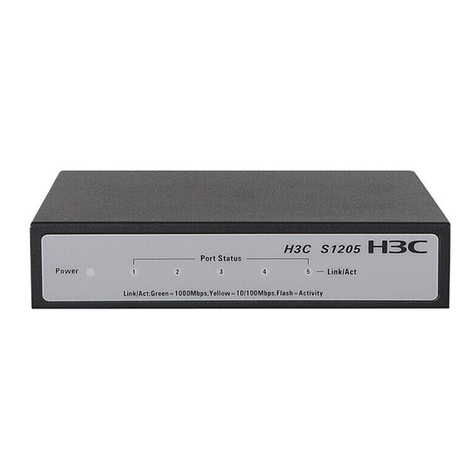
H3C
H3C S1200 Series User manual
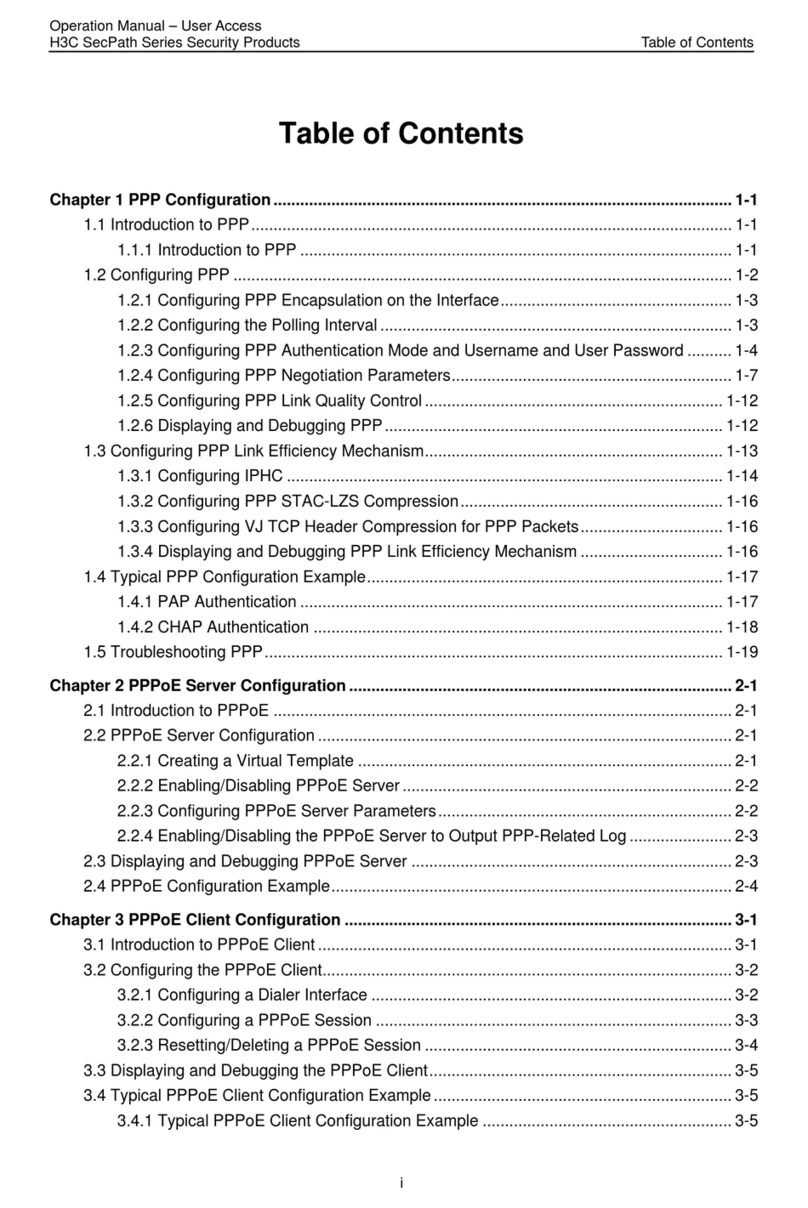
H3C
H3C SecPath Series User manual

H3C
H3C S5820V2H User manual

H3C
H3C S5120-SI Series User manual
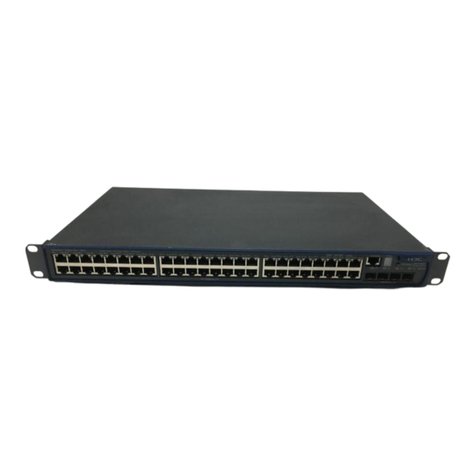
H3C
H3C S3100-52P User manual
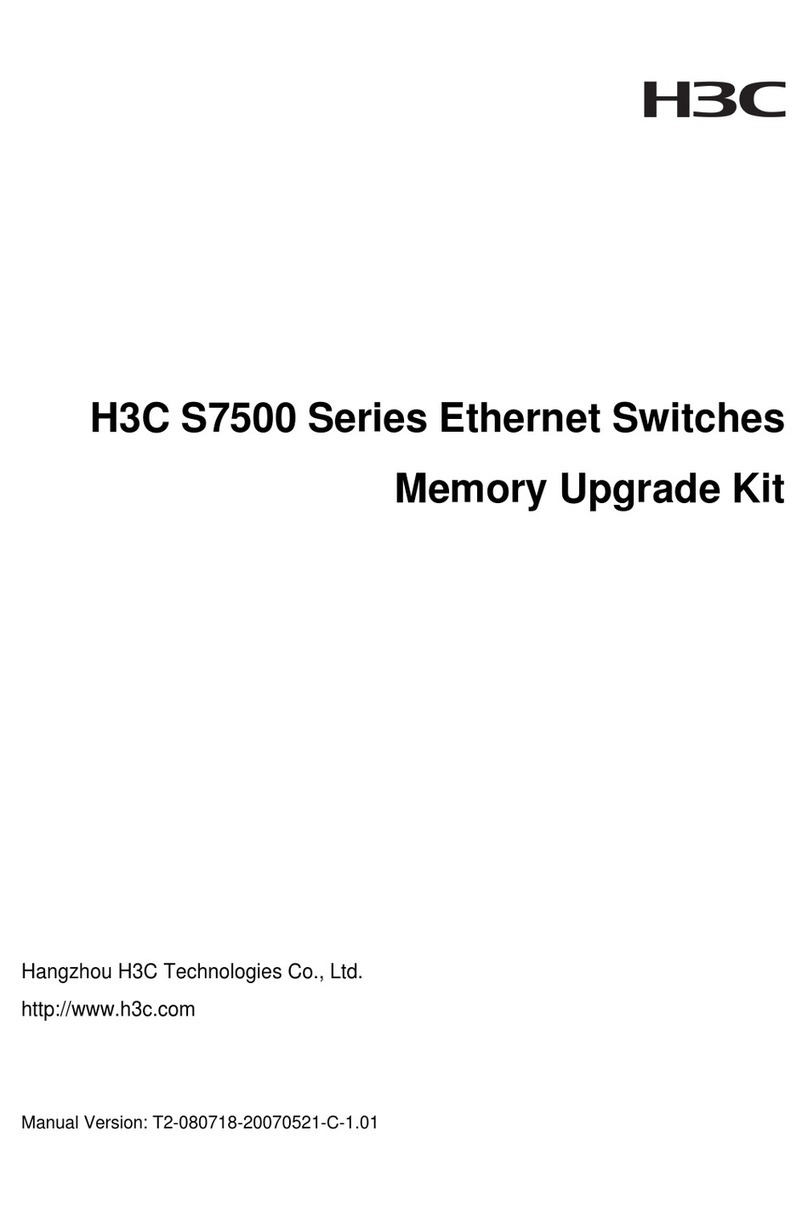
H3C
H3C S7500 Series User manual
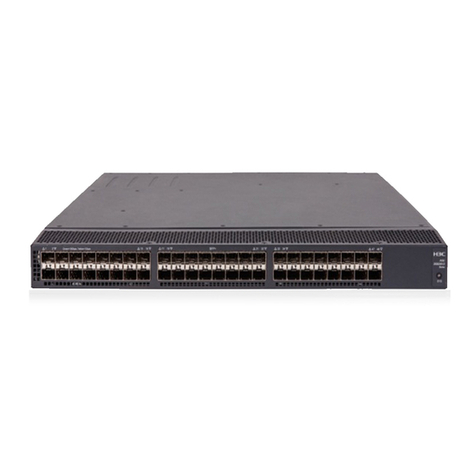
H3C
H3C S5830V2 series Installation manual
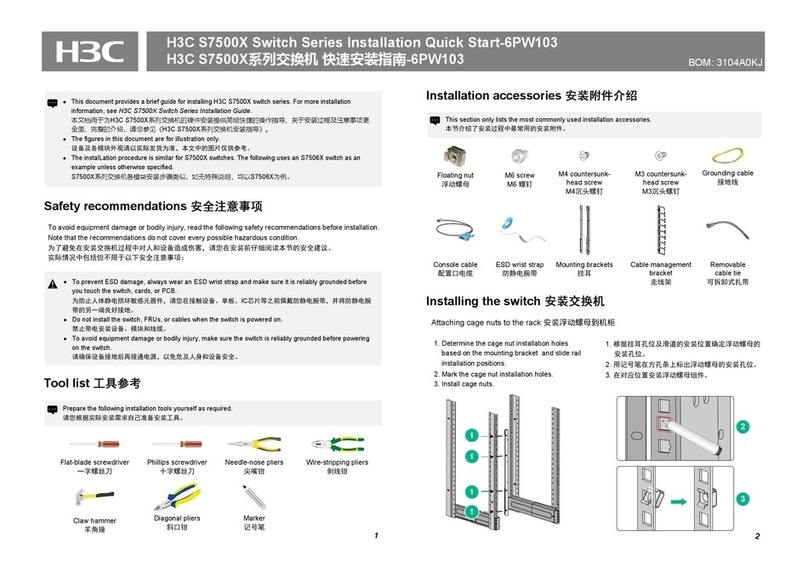
H3C
H3C S7500X Series User manual
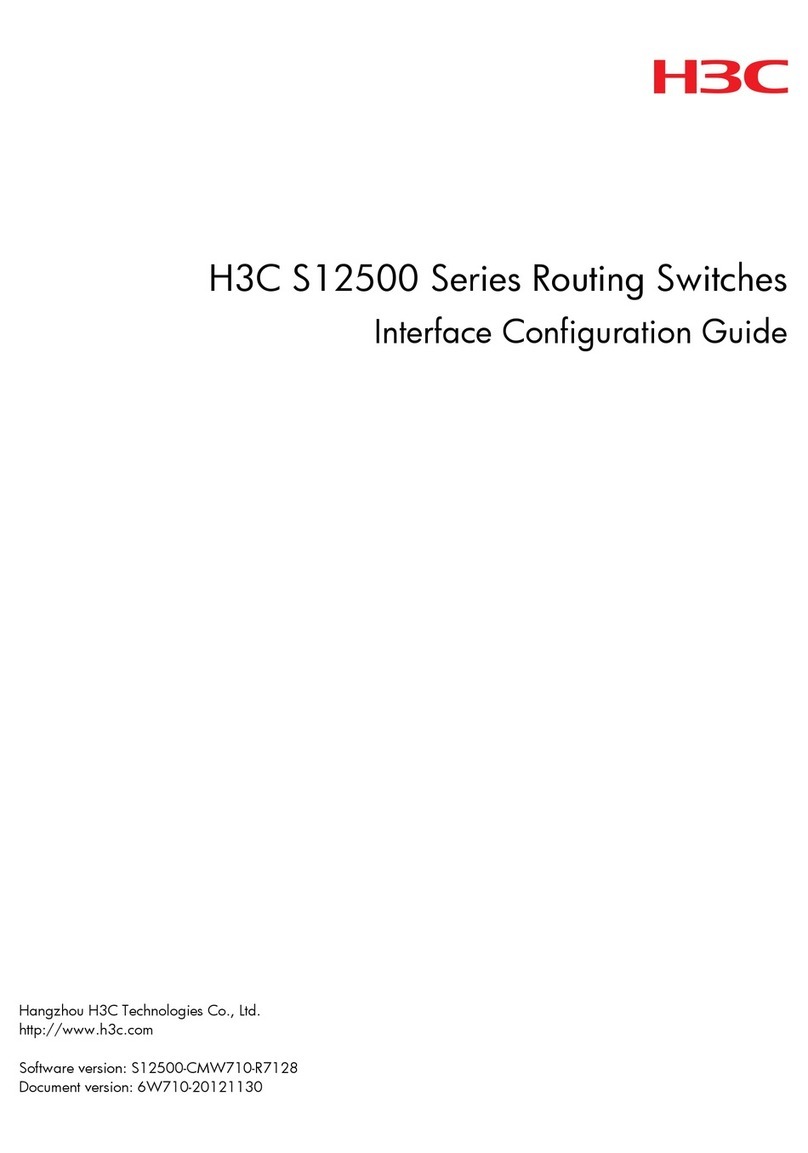
H3C
H3C S12500 Series User manual

H3C
H3C S12500 Series Service manual
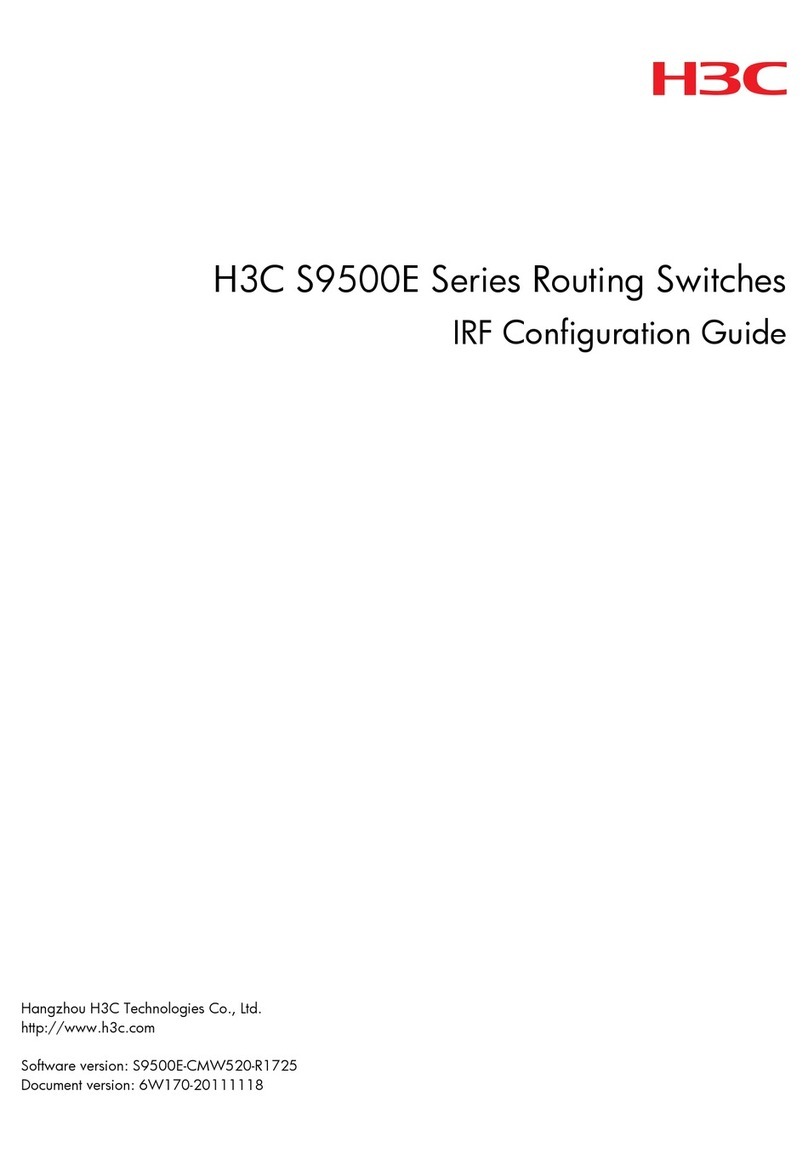
H3C
H3C S9500E Series User manual

H3C
H3C LSPM1FANSA User manual
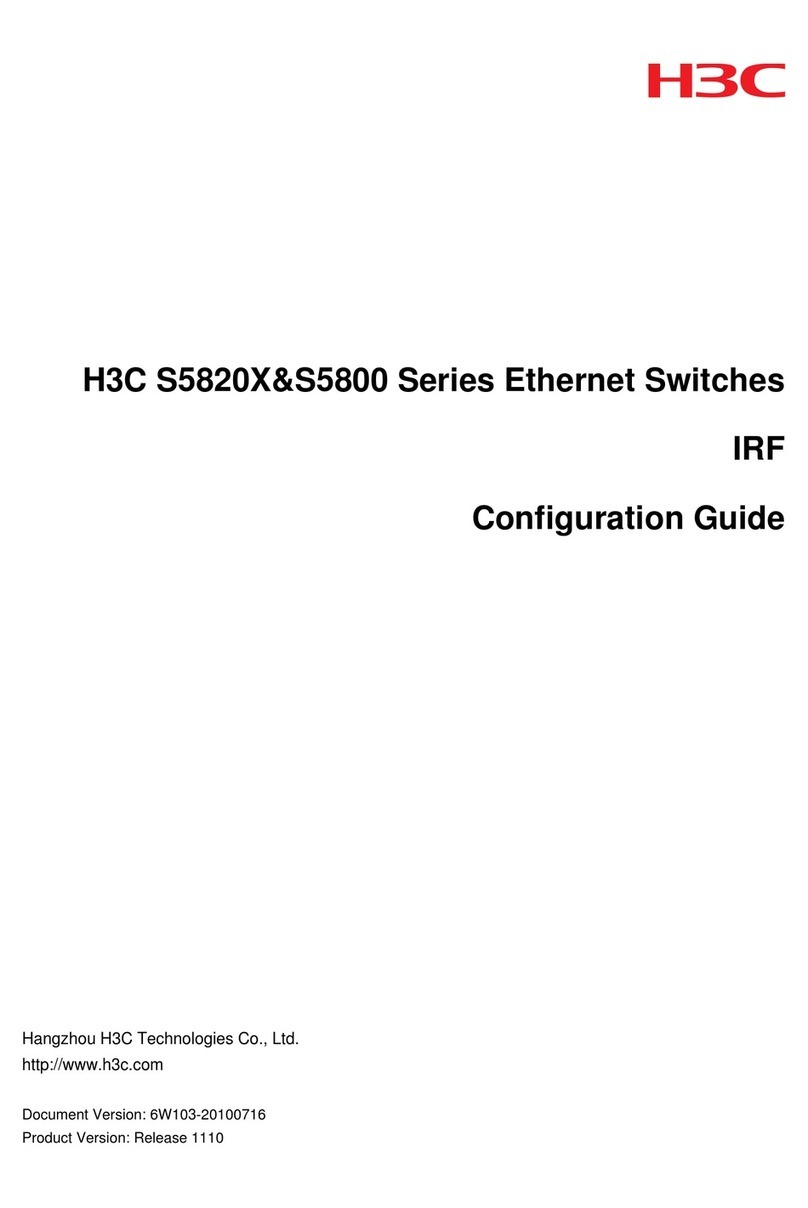
H3C
H3C S5820 series User manual
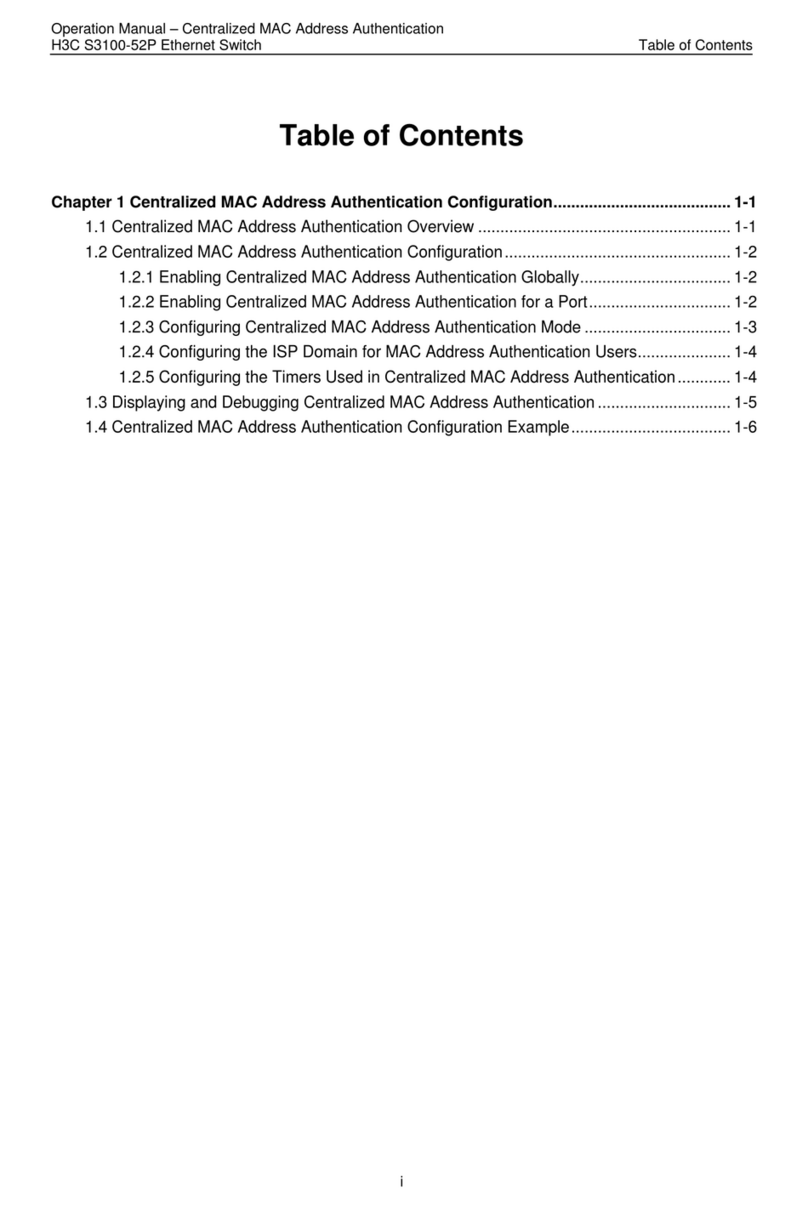
H3C
H3C HSW-2024G User manual

H3C
H3C S6890 Series User manual
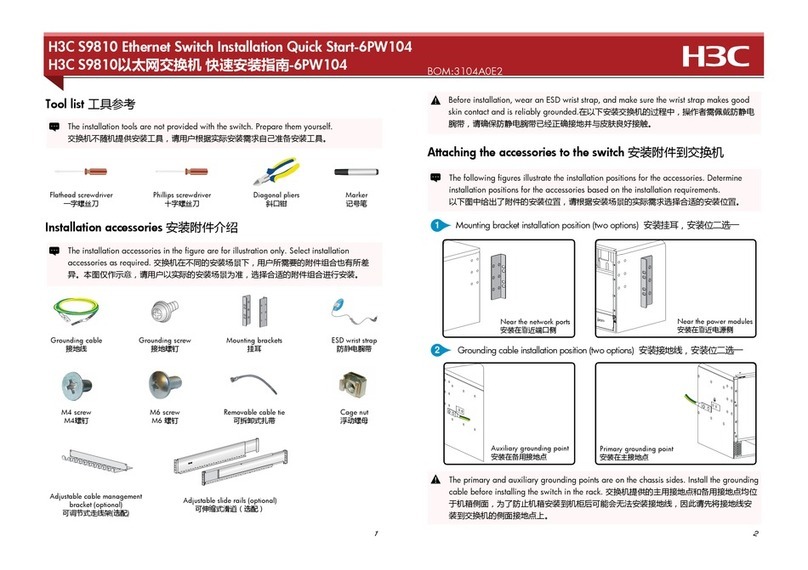
H3C
H3C S9810 User manual
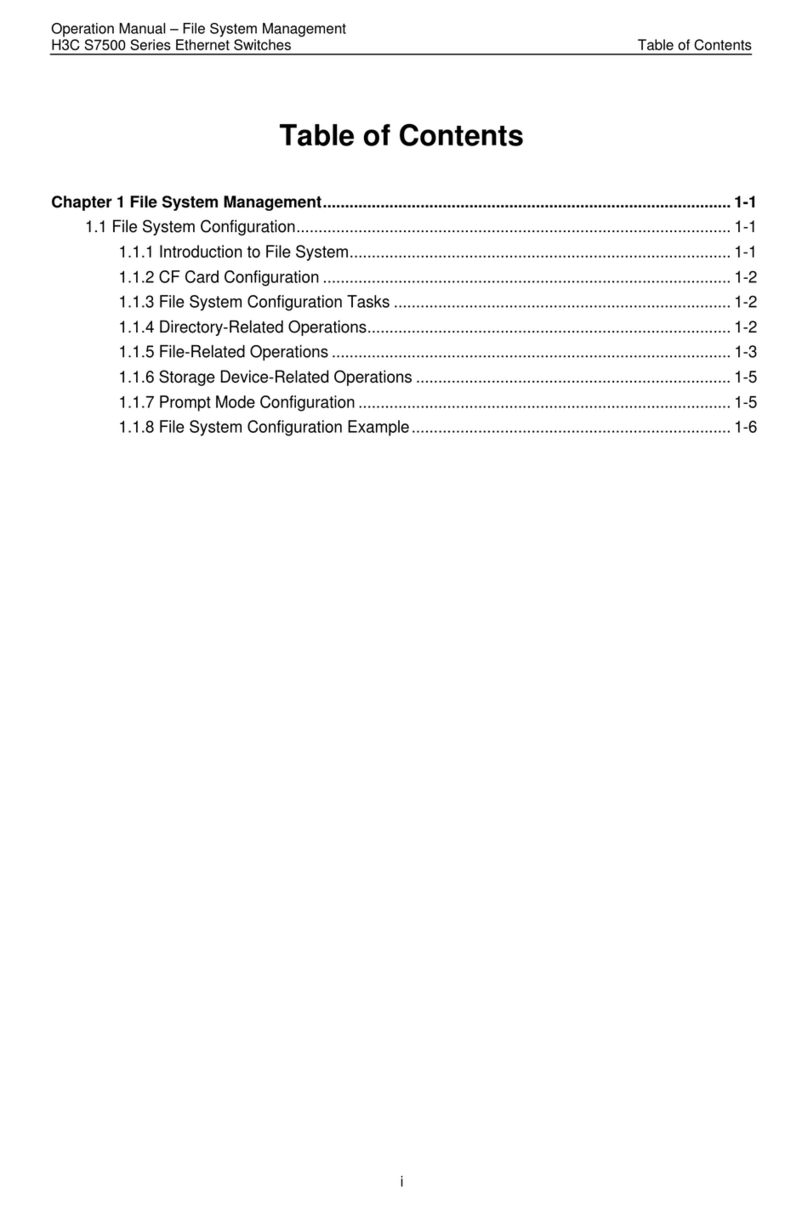
H3C
H3C S7500 Series User manual
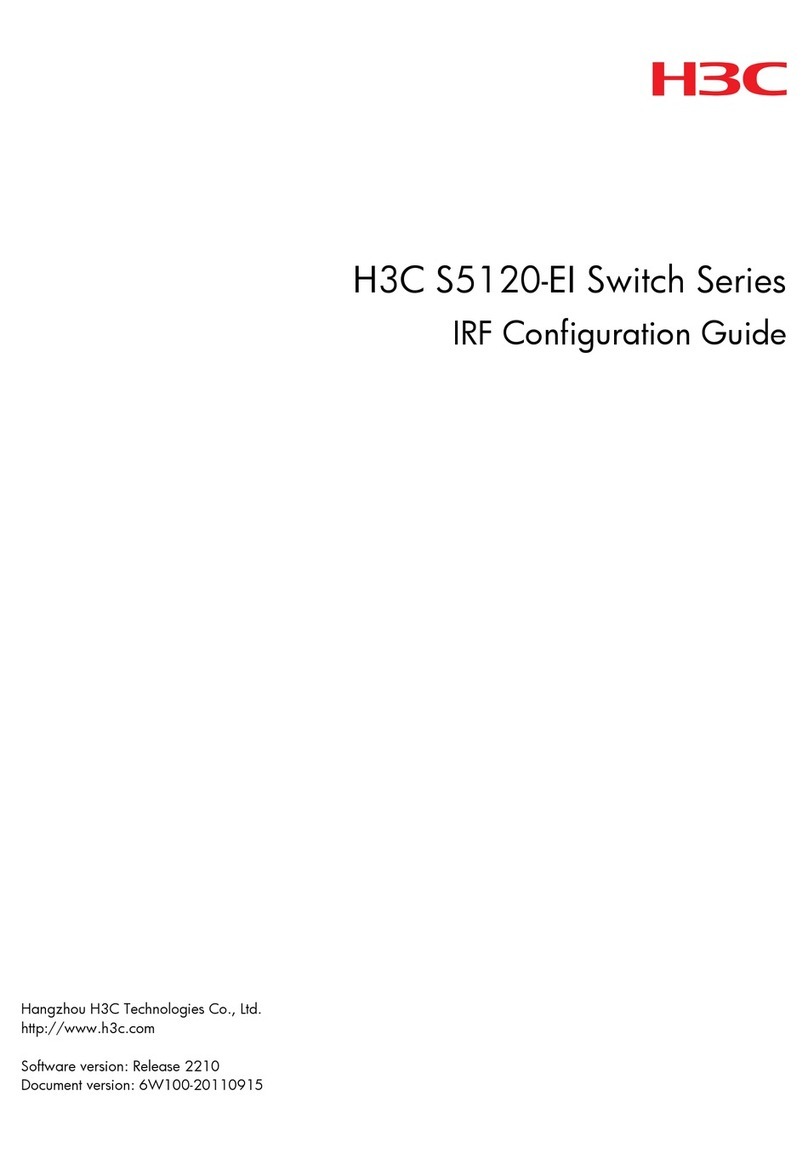
H3C
H3C S5120-EI Series User manual
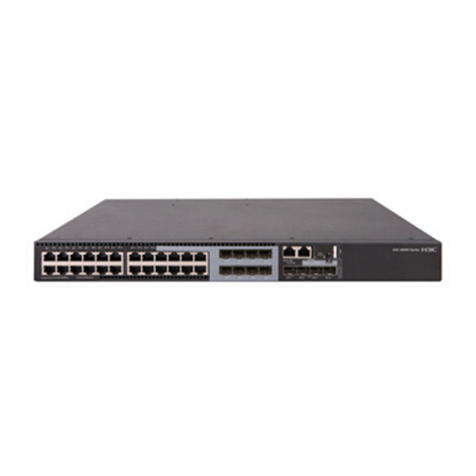
H3C
H3C S5560S-EI Series User manual
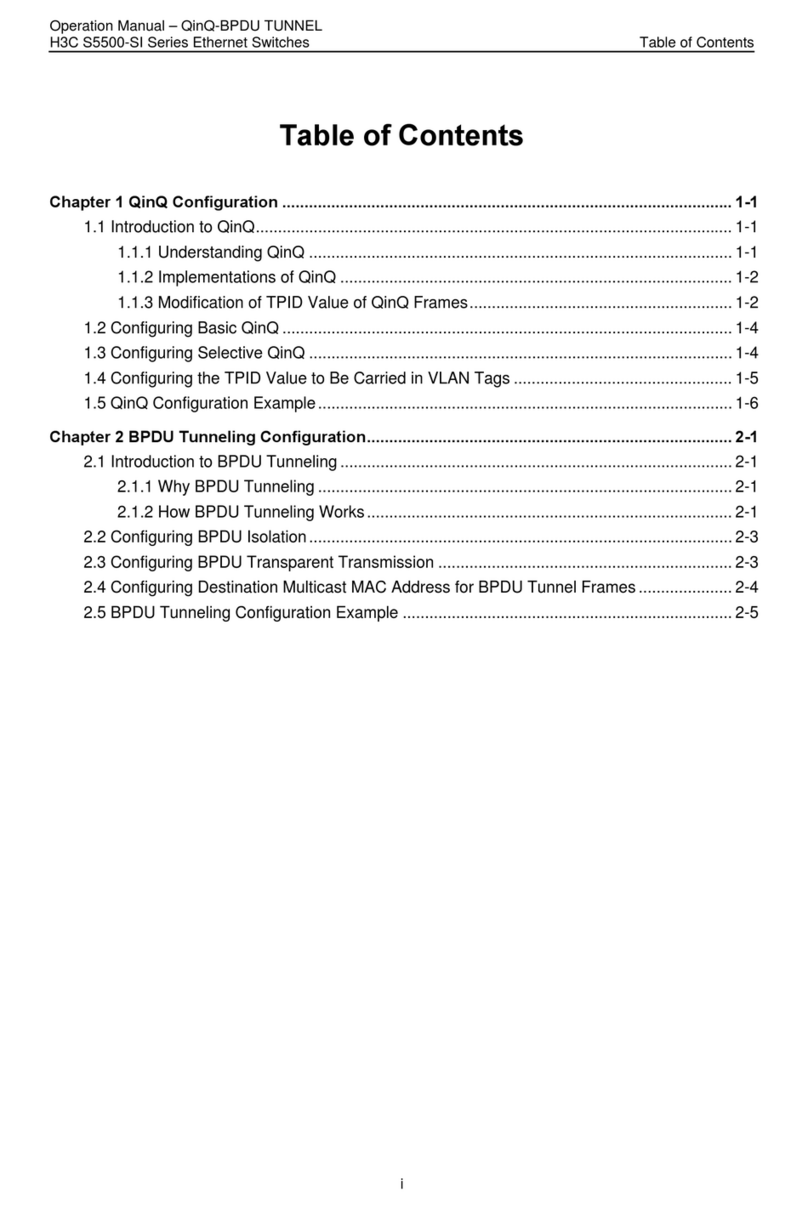
H3C
H3C S5500-SI Series User manual
